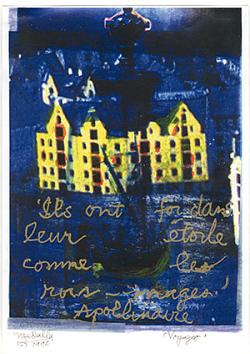Article de François Combeau en anglais
The vocal gesture"The speaking and singing voice is basically a gesture, in other words a movement of the body to express a thought or feeling." (Tarneaud) The vocal gesture is an all-embracing action involving the entire self, both physical and mental. The voice radiates from our innermost self. From the first cry at birth, the symbol of life, to the last breath taken on our deathbed, the voice (closely tied to the breath) is the lifeline bearing our emotions, hopes and fears. As the first vocal expression of the new born baby, the cry is, according to Guy Cornut, « a fundamental means of liberation tension ». It is indeed the expression of a tension, discomfort connected with hunger, pain… It is an instinctive action bringing into play all muscular groups. Just watch the face, hands and feet of a crying baby. The unity of action linking its breathing, tonicity and sound is very striking. The vocal gesture is a global muscular actionIn an adult, a cry is an irrational sound expressing anguish, a call, a prayer, torture or pain; it is the voice in its pure state, over which our conscious mind has no control. But the baby, as it becomes aware of its surroundings and its dependance on them, starts to use its voice as a language of exchange. However inarticulate, the sounds it makes become the expression of feelings that any attentive mother knows how to interpret. Gradually the vocal sounds become differentiated into gurgles of satisfaction, cries of displeasure, howls of anger, moans… The voice is an emotional bridge between the self and othersFrom the age of two to three months, a second component of the human voice starts to develop its extraordinary wealth and variety of possibilities. This is when the baby babbles. As it discovers its own body, its movements and its surroundings it emits sounds and noises and plays with them. Babbling is an extraodinarily rich and varied set of vocalisations that are pleasing to babies and that they love to repeat without giving them any special meaning… Noises made by the tongue, the lips, sound frequencies from the larynx appear at random as the baby plays, and constitute practice towards articulation and phonation. The human voice is blessed with an endless wealth of colours, tones and soundsThe child then begins to attune its vocalizing system to what it is able to hear. It begins to imitate and to give a more precise meaning to the sounds it makes… The idea of vocal play gradually fades away. The sounds produced become poorer, and very soon the spontaneity and globality of the baby’s prattle are forgotten. Timbre, tone and sound intensity are evened out, and the conscious mind increasingly takes control. The voice, breath and muscular activity are no longer intimately linked ; slowly but surely vocalization and gesture move further apart. Through the voice, the inner being is expressedThe testimony of a blind girl, Paula Arbel (« Sorcière » journal on the voice) is extremely revealing in this respect. She wrote: « for the past two years I have been living in the dark night of blindness… The experience has made me realize that in the same way as faces, each voice is an intriguing phenomenon, a mystery, an adventure… For me it no longer represents an accessory but the person as a whole… The voice expresses sensuousness and is addressed to my own sensuousness. The essential, which cannot be seen with the eyes, without doubt is conveyed by the voice… The being springs out through its voice, thereby offering a spectacle that can be watched eyes closed. » "Beyond music and language, the voice is a permanent emanation of life, a proof of our existence." (Betsy Jolas, Voix et musique) There is no such thing as a good or bad voice. There are only voices waiting to be discovered. In our work, we try to restore the natural vocal gesture, its incorporation in the body, its capacity to convey our feelings, our sensuousness, and to meet our intentions. The voice is sound energy, communication energy…It connects the person to his or her surroundings and inner being through resonance. Rediscovering the natural gesture, the dynamics of voice projectionOnce emitted, the voice must reach the hearer’s ear. The sound has to meet accoustic requirements for it to travel all the way. In his study on the various vocal techniques and their relationship with voice compass, Helmut Lips gives us very useful information in this connection.
The voice must radiate from the person’s entire body and mind. |





